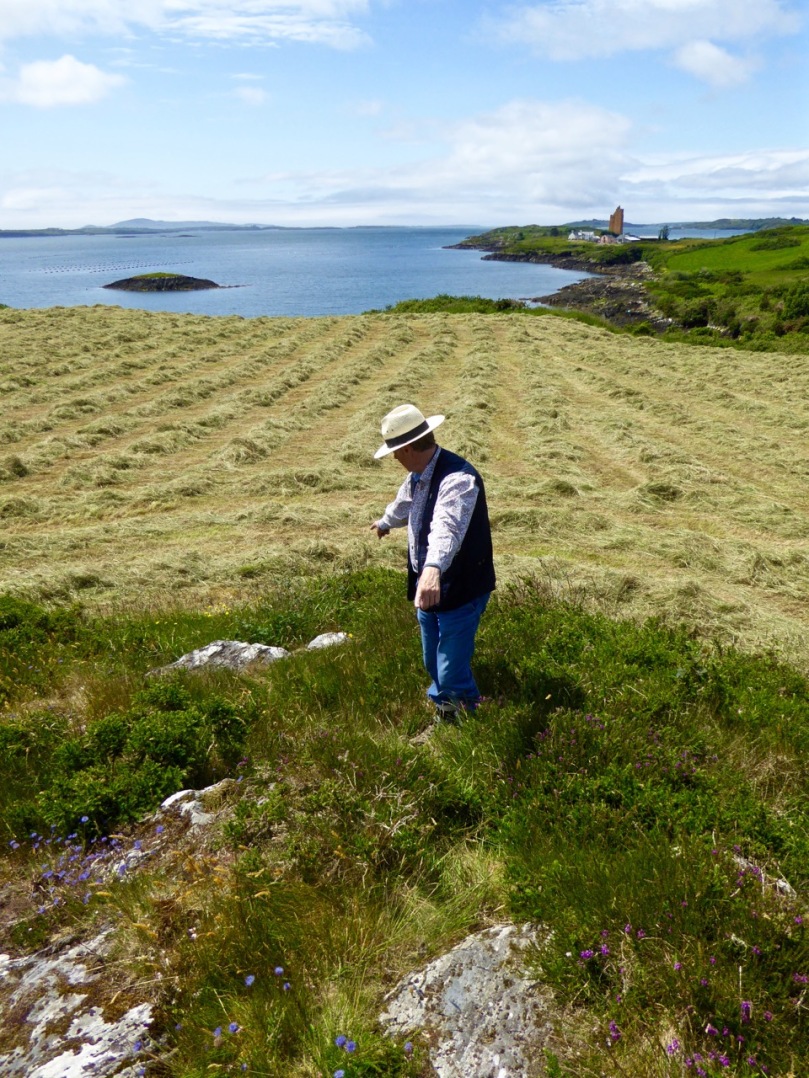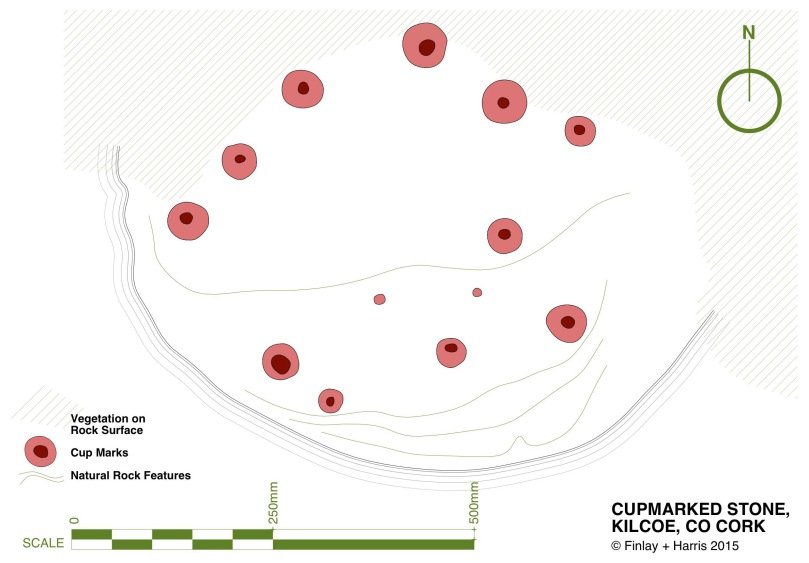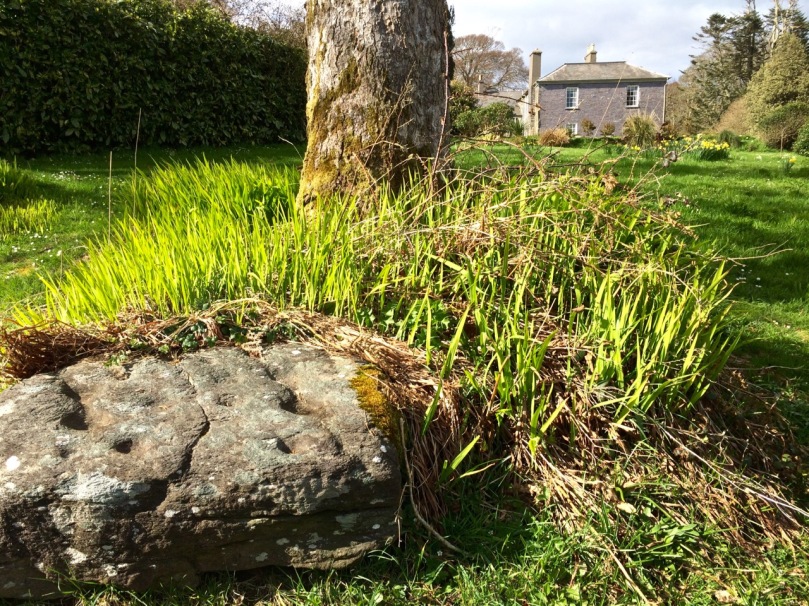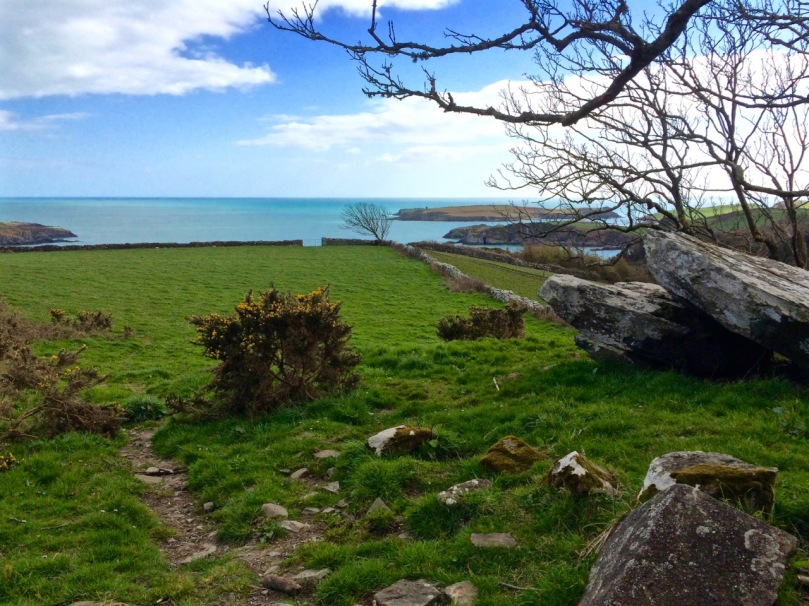
Rathruane More: the view from the rock art site includes a knoll with a row of cupmarks on its upper surface, and Mount Gabriel on the horizon
QUESTION: Is there a real difference between rock art and cupmarked stones?
A joint post by Finola and Robert

Distribution of ‘rock art’ (left) and ‘cupmarked stones’ (right) in Ireland, according to the National Monuments classification scheme
In recording the rock art of County Cork so far we have concentrated mainly on those examples described in the National Monuments Records as rock art. In the course of planning the Cork survey, years ago, a decision was made to distinguish between rock art and cupmarked stones and so they are listed separately. However, other counties appear to lump them together, or use the generic term rock art to include stones bearing only cupmarks. In addition, some monuments are classified using their most distinctive feature: a wedge tomb or a standing stone, for example, may well bear cupmarks on a surface, but do not therefore show up as examples of either rock art or cupmarked stones on the records.
This is how the National Monuments Website describes cupmarked stones: A stone or rock outcrop, found in isolation, bearing one or more small, roughly hemispherical depressions, generally created by chipping or pecking. There are a total of 99 examples listed in Ireland, of which 64 are in Cork. However, as we have seen above, this is an arbitrary and misleading classification and varies from county to county. The number of cupmarked stones that fit the NM description is likely to be much larger. The question is – should we preserve this distinction between stones labelled rock art and those labelled cupmarked stones? Is it useful or merely confusing?

Rathruane – included in the list of rock art because, besides numerous cupmarks, it also has cup-and-ring marks, a rosette, and lines. The first photograph in this post was taken from this surface
The cupmark is the most basic and numerous element or motif of rock art in Ireland and elsewhere. In the examples labelled rock art in County Cork, they occur with other motifs, principally concentric rings, sometimes with radial grooves, and a variety of curved or straight lines. They can be incorporated within a motif (as in cup-and-ring marks, rosettes, or where enclosed by lines) or they may be scattered, seemingly randomly, over the surface of the rock, between and among the other motifs.
The two images above are from the shores of Lough Hyne. Two cupmarked stones lie on the beach, having probably fallen from the stone wall above. The right hand image is Robert’s drawing of the stone with 12 cupmarks
Since we have almost finished our recording of the rock art examples, we have moved on to focusing on those labelled cupmarked stones. As we spend time in the field recently with this class of monument we have begun to appreciate their differences from and similarities with rock art.
This simple cupmarked stone was placed many years ago within Knockdrum Fort, near Castletownshend, in the townland of Farrandau. It was brought to Vice-Admiral Boyle Sommerville by a local farmer
Let’s start with what differentiates them from rock art, apart from the obvious fact that the cupmark is the single motif employed in the carving.
- Where a stone is smaller and moveable, it is more likely to bear only cupmarks. This also makes them more vulnerable to loss and to incorporation into field walls and other structures. While there are examples elsewhere, here in Cork we have found no examples of cup-and-ring carvings on small, easily moveable, stones.
- We have found cupmarks on boulder burials here – Bohonagh is a good example, and Derreennatra (currently hidden under a mound of compost) may be another.
- In general standing stones, where they have carvings, are more likely to have only cupmarks (we have three exceptions to this in West Cork).
- The Bluid stone has cupmarks on both sides – there are no Cork examples with rock art on both sides.

The Bluid Stone is in Cork Public Museum but comes from near Castletownshend. It is a rare example of a stone with cupmarks on both sides, quite portable. Note the semi-circular patterns of the cupmarks
Now – what’s the same?
- Location: Most cupmark-only carvings are found in the open countryside, on large earthfast boulders or rock outcrops.
- Clusters: as with rock art, cupmarked stones are often found within a kilometre or two of other examples or are within sight of each other or within site of rock art (intervisibility).
- Carving technique: where it can be discerned, it appears to be the same as for rock art – pecking with a harder stone. In the case of some of the shaley sandstone that laminates easily, it is impossible to tell how the cupmarked was formed – it may have been simply bashed out.
- Siting: where the cupmarks are found in situ, their siting is equally spectacular to rock art. In particular, many of them are found on rising ground with strongly marked horizons that include views, even quite distant views, of Mount Gabriel, Mount Kidd, or other prominent horizon features. The sea, or water in the form of a lake, stream or river, is often a feature of the vista from the rock. We have not worked with enough of them yet to form any opinion on whether they are sited at what may have been routes through a landscape or territorial boundaries.
- Patterns: as with more complex rock art, often the cupmarks appear to be scattered randomly over the surface of the rock. However, patterns of straight lines, or of rough circles or semi-circles, can be made out in several of the stones we have recorded to date.

Robert points to two outcrops in Kilcoe. The lower one has one cupmark, the upper one has 13 cupmarks arranged in a rough circular patter. The sea and Mount Gabriel are visible from this location, as well as some rock art
In researching this piece we have been influenced by Christiaan Corlett’s book Inscribed Landscape: The Rock Art of South Leinster. Christiaan is an archaeologist with the Dept of Arts, Heritage and the Gaeltacht and specialises in the archaeology of Leinster, and especially Wicklow. His book has been the first to catalogue the extensive body of rock art in the South Leinster area (indeed the first published work on rock art in Ireland) and in his corpus he includes both cup-and-ring art and cupmark-only stones without undue distinction. He notes many of the same things about rock art that we have observed. For example, he was struck, as we were, by the dominance of high mountains (in his case, Mount Leinster, the Blackstairs, or Brandon Hill) in the horizon views from the rocks he studied, and by the intervisibility of stones from each other.

The newly-discovered Kilbronoge cupmarked stone. From it you can see Roaringwater Bay and a wedge tomb to the SE, and Mount Gabriel diametrically opposite in the NW

Robert’s drawing of the Kilbronoge Cupmarked Stone, made using architectural survey and CAD techniques
His work is a strong argument for the inclusion of all cupmarked-based prehistoric carving under one rubric – rock art. First of all, he argues that it is all likely to be of a similar early origin. Recent thinking is that rock art may predate megalithic art and belong to the Early Neolithic (at least 5,000 years old). In fact, the cup-and-ring art may already have been dying out during the great flowering of megalithic art that we see at Newgrange, Knowth and Loughcrew. Cupmarks on their own may have persisted longer, as they are found in association with Bronze Age monuments such as wedge tombs and boulder burials. Here’s what he has to say about our search for meaning, vis-a-vis the humble cupmarked stone (p.78):
Arguably, it is only within the context of the overall composition that we may come close to some comprehension of the motifs found in rock art. Even the meaning of a completed composition, however, may only have been understood by the person(s) responsible for it. Perhaps the symbols represent a complex message of family history or a personal spiritual journey associated with an initiation ceremony or rite of passage, or perhaps they simply served to delineate family, tribal or sacred boundaries… [There is] a natural temptation to focus on the more elaborate designs and compositions found in rock art, as if they are more important because they are more accomplished. Yet the frequency of compositions consisting solely of plain and unelaborated cup-marks should not devalue their significance. Clearly their commonness would strongly suggest that these examples were just as important as, or maybe even more important than, the most elaborate examples of rock art found in the region. Given the intrinsic simplicity of a composition consisting entirely of cup-marks, however, it is arguably impossible to decipher or decode the specific meaning of the symbols themselves. That is not to say, of course, that we cannot attempt to understand the broader message of rock art, particularly where a complex of sites can be analysed. In such cases it may be the context of these sites that will provide the key to unlocking the meaning of rock art, in terms of the position and relationships within a given landscape, and the relationship with other examples of rock art on the vicinity.

The Kilcoe Cupmarked stone. The original record described three cupmarks – in fact there are 13, arranged in a rough circle
Christiaan deals with the similarity of cupmarks to the bowl-shaped depressions known as bullauns, assumed to be Early Medieval. But that’s a topic for another day. Suffice it to say here that one of our favourite stones, Castlemehigan, may have both cupmarks and bullauns on its surface, as well as a cross indicating its later use as a mass rock. In its extraordinary mix of seemingly-randomly-scattered but also possibly-linear-arrangement of cupmarks; large bowl and basin-shaped elements; a spectacular siting that includes views to a distant Mount Gabriel and a closer view of the sea; a nearby cluster of other cupmarked stones; and the folklore that surrounds it – this very special cupmarked stone embodies all that is wonderful about this class of ancient monument.
To come back to the question we posed at the beginning – should we preserve or abandon the notion that we are dealing with two classes of monument – rock art versus cupmarked stones? Our answer is that we’re not sure. What do YOU think?
For those interested in more of our posts on rock art, go to Derrynablaha Expedition and scroll to the end for a list.









Having spent a few days on Sherkin last year, it was only minutes before my departure on the boat that I read your article in the Sherkin Comment which alerted me to there being this separate category for cupmarked stones. Ah…
Thank you for that. So I must return to Sherkin.How bad.
Despite my being uncomfortable with the term rock art, I do go with the idea of a general classification of rock art and its various sub-categories. But then, what about passage tomb art?
In the article by Elizabeth Shee Twohig et al, “Open-ar Rock Art at Loughcrew, Co Meath” , The Journal of Irish Archaeology, Vol. 19 (2010), it was suggested that we should recognise three groups of prehistoric Irish stone carvings: (1) classic passage tomb art; (2) cup and ring-type rock art, occurring on outcrops and boulders, and occasionally on standing stones; (3) ‘other’ art, occurring on anomalous megalithic tombs, cists, standing stones, etc.
LikeLike
I enjoyed this piece and the photos continue to be stunning – is this the new camera settling in Finola ?
In my musings on ancient man it suddenly occurred to me that could cup marks be attempts to ‘draw’ a star constellation – or at least a group of stars that had a significance to these people. Living under the sky, unlike us modern people, the heavens must have been a constant source of wonder and discussion. Maybe each tribe ‘bagged’ a star cluster as there own ??!!
Am I right in thinking, Robert, that cup marks are absent from the Dartmoor area ?
LikeLike
Thank you Perran. I have emailed you a detailed response, but for the benefit of readers here it’s worth noting that you have touched on a subject on which a huge amount has been written and argued. Not just Rock Art and cupmarks, but standing stones, circles, passage graves etc do have solar and astronomical alignments, without doubt. However, pinning down the reasons for this is the challenge. Any further comments on this, anyone?
LikeLike
Some 70 cupmarked stones are said to be recorded in ‘south-west England’. The greatest concentrations in England generally seem to be in Cumbria. Here’s a link to one on Dartmoor:
http://www.megalithic.co.uk/article.php?sid=10606
LikeLike
I would think they should both be considered under the umbrella of ‘rock art’, just like pictographs showing animals or weapons are known in different countries as ‘rock art’. I guess the problem is sub-classification hasn’t been implemented the way it is for megalithic tombs, for example. They are all listed as ‘Megalithic Tomb’ first, then classified as ‘Passage Tomb’, Wedge Tomb’, ‘Portal Tomb, ‘Court Tomb’ etc. So a better solution could be a general classification ‘Rock Art’ then sub-classifications of ‘Cup and Ring’ or ‘Cup Marked Stone’. I think there is some value in knowing how many of each there are and what distribution they have, this can be useful to understand what the inventory is like in certain areas. In Wicklow, where I am for example, there are many more cup-marked stones than those with cup and rings, while in Kerry there is probably a lot more cup and ring carvings than cup marked stones. It’s interesting to try and work out why that might be. Having just one term for ‘rock art’ wouldn’t show up that distinction as on your distribution maps above.
LikeLike
This looks like a good solution for the National Monuments records. There is such inconsistency in how things are recorded in there (and so many pieces that simply say “no information” that it would take a real conserted effort to sort that out.
LikeLike
I see no essential distinction between cup-marked sites and those that have more ’embellishment’… but I’m just in my armchair so can’t back that up empirically, but to attempt an empirical distinction might be barking up the wrong tree.
LikeLiked by 1 person
Aha – one for the Lumpers camp.
LikeLike
Reblogged this on West Cork History.
LikeLike
What a conundrum! I’m going for the all inclusive rock art label! The Kilcoe stones look amazing – what a setting and the Castlemehigan is the most fascinating – so many different motifs and features.
LikeLiked by 1 person
Another for the Lumpers.
LikeLike
Or the cup-mark complex, sufferers are prone to ponder on the intangible!
But seriously it is a very interesting question and as Christiaan suggests we may not get to their meaning but perhaps come to some understanding by looking at their setting and distributions. It seems that the distribution of “cup-marks” and “rock art” in Ireland is different in some cases; in particular in West Cork you have a preponderance of cups over rock art in the Iveragh Peninsular. The same is true here in the Cumbrian Mountains where the majority of the sites are cup marked alone on bedrock, the neighbouring Eden Valley and Dumfries and Galloway has a more pronounced preponderance of the cup-and-ring tradition over cup-marks alone. So like you I’m not sure, but its an interesting distinction and separating the two certainly throws up some interesting questions. Are the cup marks the older, or just different tradition? I do wonder given that here we have the stone axe quarries which were in use from over 5500 years ago.
LikeLiked by 1 person
Another conflicted response, but tending towards the Splitters?
LikeLike
Probably with Ken and the sub-divisions within the HER, but we really need a consistency across the records in the different countries in Western Europe where they occur to enable some better interpretations.
LikeLike
Although I sometimes use “rock art” I prefer cup marks and think it would be good if we could abbreviate that to CM or CRM. Or we could use their Gaelic name “Clachan Aoraidh”. Do you have a latitude and longitude for the CM boulder in the first picture?
LikeLike
Do you mean that you use the terms separately or synonomously? What is CRM short for?
I don’t have a GPS reading for the boulder but it’s right beside the rock art site “Rathruane More” (CO140-008—-) in the National Monuments Service Database. http://webgis.archaeology.ie/NationalMonuments/FlexViewer/
Looks like you’re just getting started with your blog and it looks great so far. Keep up the good work! We’ve signed on.
LikeLike
As objects purposely manipulated by humans, cup-marked stones should be included with other rock art. Sometimes the categories overlap, as in the North Yorkshire “Tree of Life” rock. http://www.stone-circles.org.uk/stone/treeoflife.htm
LikeLike
One more Lumper!
LikeLiked by 1 person